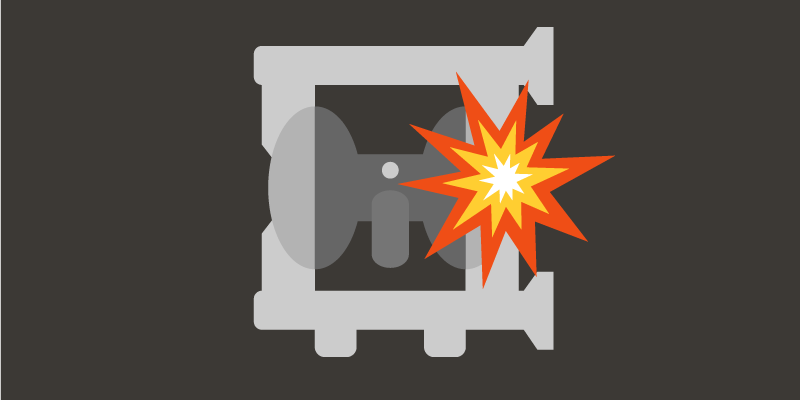When crucial elements of your process breakdown or rupture, the effect is felt throughout the business.
To ensure your air operated diaphragm pumps (AOD) work efficiently and do not cause massive downtime for your team, Global Pumps share their knowledge.
In this video, Global Pumps show you how an AOD pump operates.
Why are ruptured diaphragms a big problem?
Any spills from AOD pumps can cause both environmental and cost concerns. When they do occur, employees are required to clean-up - using various products to absorb the spill and later disposing of it into a waste container. It is also very dangerous when the fluid spilled is hazardous, corrosive or flammable - putting the environment, staff and your premises in risk.
If pumping expensive fluids, such as pharmaceuticals, food, cosmetics, perfumes or beer and alcohol, a rupture can be a costly experience.
 Don't let your diaphragm burst and cause downtime.
Don't let your diaphragm burst and cause downtime.
Why do diaphragms rupture?
There are several reasons why air operated diaphragm pump diaphragms would rupture. Diaphragms will fail naturally (from fatigue), as with anything that gets bent back and forth. Different materials last longer than others, for example Buna-Nitrile diaphragms will last longer than Teflon diaphragms, but you must consider chemical compatibility. Most manufacturers overcome the shorter life of the Teflon diaphragms by making them thinner and then using a rubber back-up diaphragm to give it structural strength. Other common reasons diaphragms fail is application based i.e. running the pump dry, deadheading the pump, high inlet pressure, or operating the pump higher than the maximum air pressure ratings.
Doing any of these will lead to leakage, bent inner plates and shaft, bulging and ripped diaphragms.
When the diaphragm ruptures, fluid fills the air chamber and sprays out the muffler. Worse, if there are chemical compatibility issues, the air end of the pump is simply destroyed.
Preventing your diaphragms from rupturing
As diaphragm ruptures are preventable, Global Pumps suggest the following to avoid their failure:
- add a regulator to the pump: this controls the amount of airflow into the pump, regulating the stroke speed and extending the life of the diaphragm. Over-pressurising the diaphragm can cause it to bubble out and fail faster.
- deadheading / dry running the AOD pump: while this is a feature of the diaphragm pump over and against other types, this will shorten the life of the diaphragms.
- use a one-piece diaphragm: a one-piece diaphragm can withstand more pressure than the standard diaphragm. Due to its construction, it can handle excessive pressure and provide a longer service life.
- select the right pump from the start: as with all pumps, an AOD pump does not suit all applications. There are some instances that require an alternative type of pump. It is important during the selection process you understand the fluid’s properties, the process and the limitations of the pump doing the work. We cover this off in our e-book – “Guide to selecting the best pump”.
Preventative maintenance ensures that your AOD diaphragm does not fail and cause downtime or greater long-term costs. If your AOD pump is pumping expensive, dangerous or flammable liquids, Global Pumps recommend implementing preventative measures to protect your staff, premises and the environment in which you operate.
For more information on AOD diaphragm ruptures, or to discuss how you can implement preventative measures, chat to Global Pumps. Our team have comprehensive understanding on AOD pumps and how to ensure they continue running efficiently and effectively.


